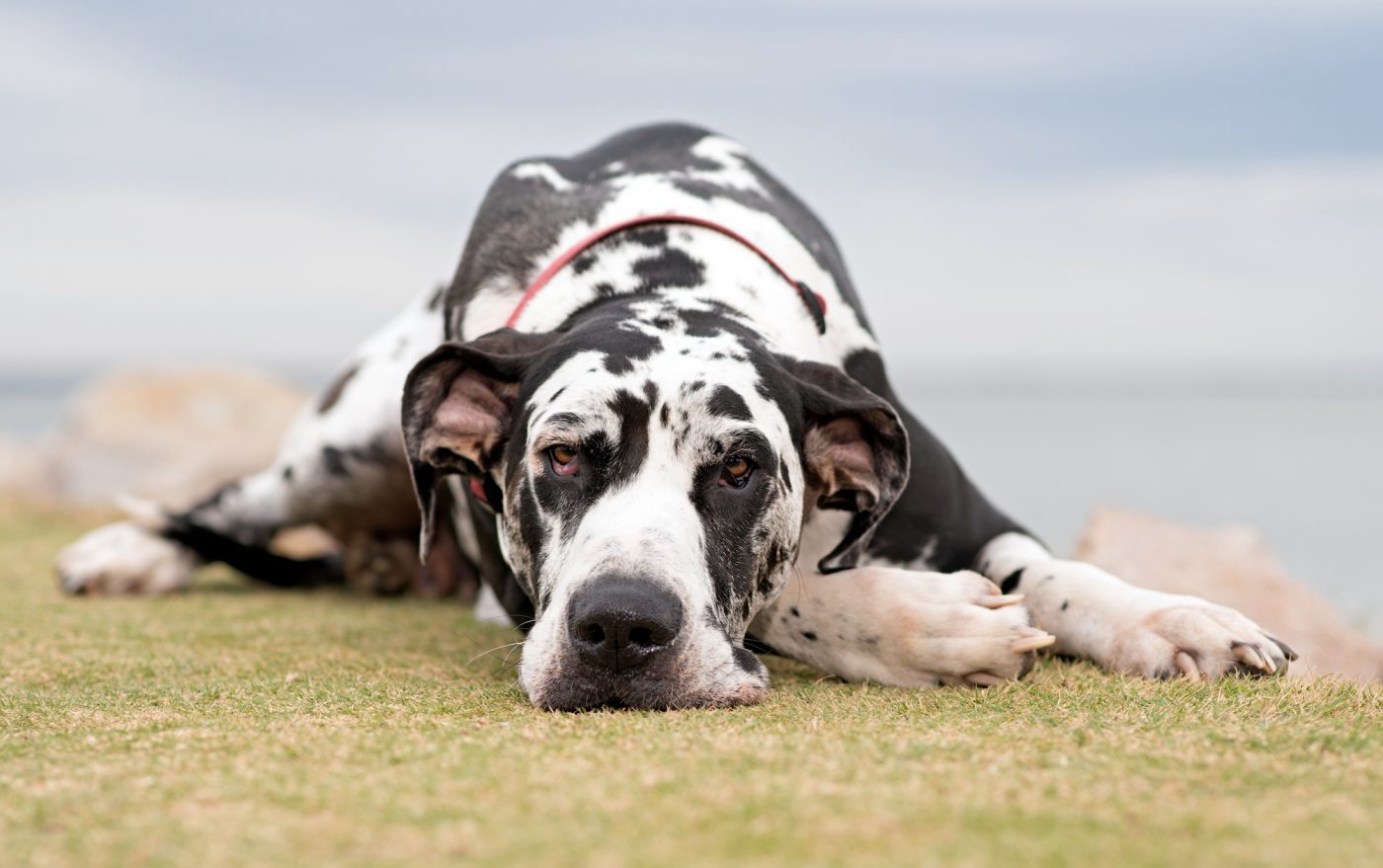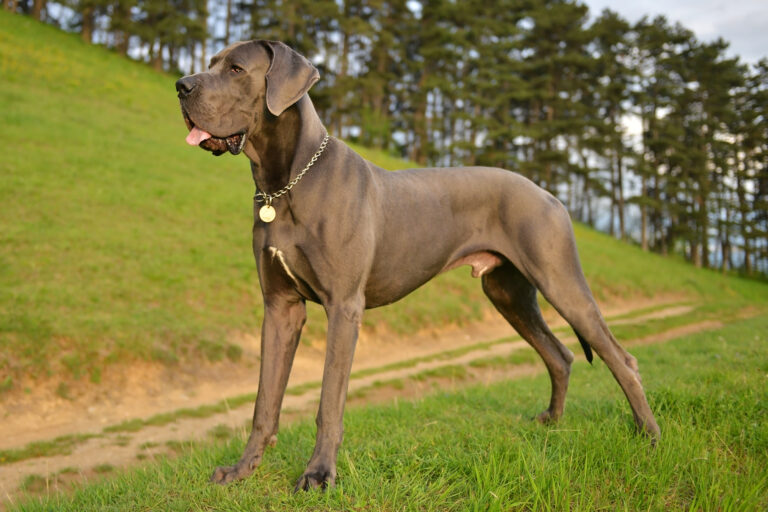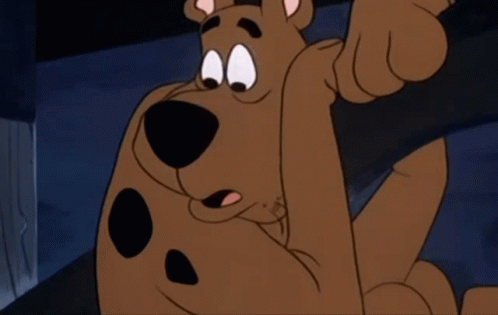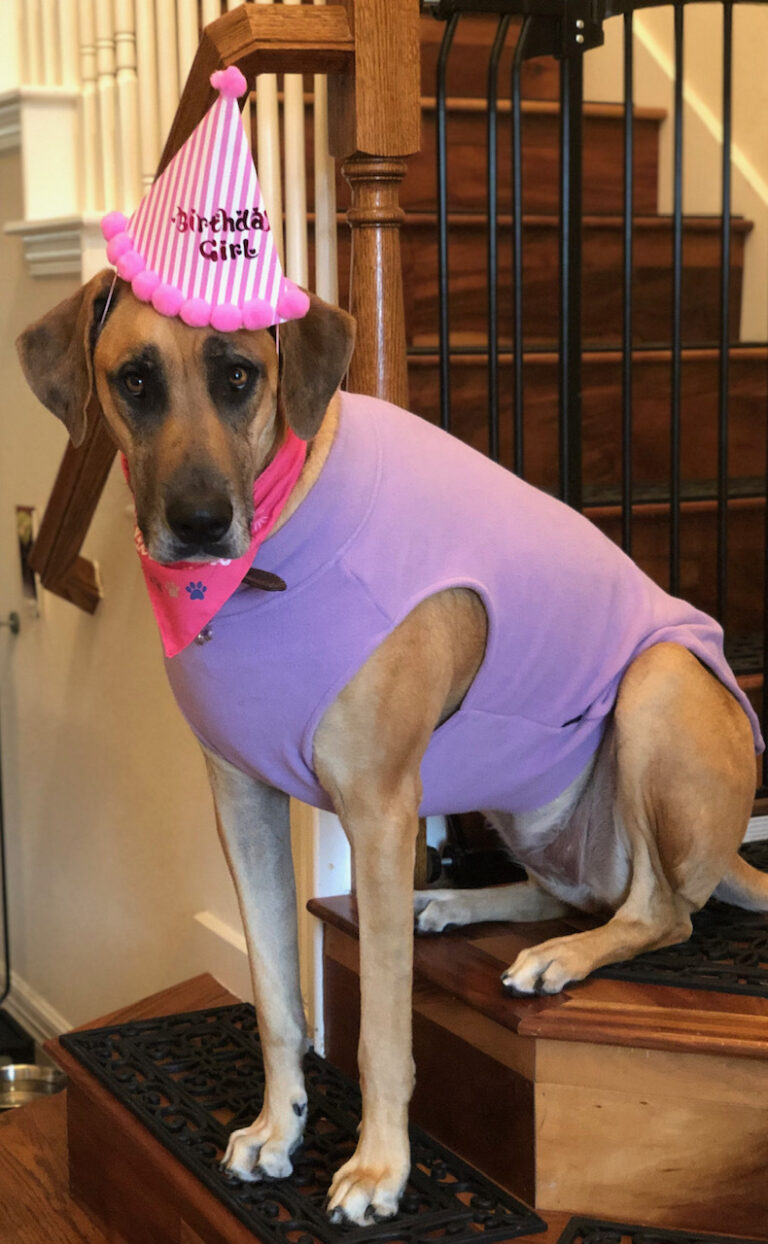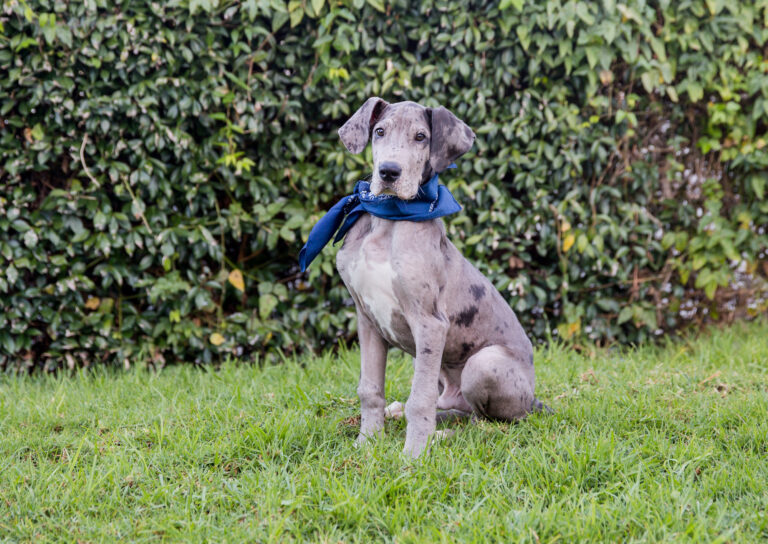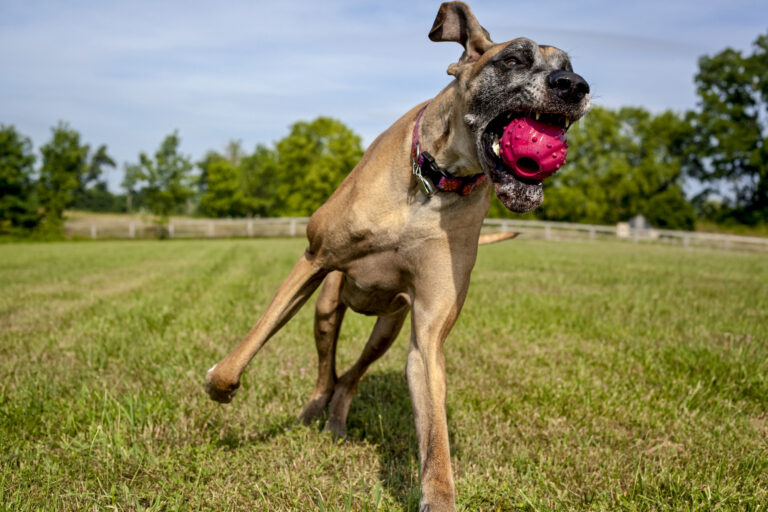With an extra-large body and a personality to match, Great Danes attract attention wherever they go. Though they’ve historically been hunters and protectors, these days you’re most likely to find these friendly giants as beloved family companions. Taking care of one can be rewarding, but also a handful. They require tons of training, attention… and, yes, food. We’ve put together some tips that can help you decide whether to bring one of these Brobdingnagian buddies into your abode—or, if you already have one, make sure you’re doing all you can to be the great human your Great Dane deserves.
Basic Great Dane facts
According to the AKC, male Great Danes typically stand 30-32 inches tall and weigh 140-175 pounds, with females clocking in at a comparatively petite 28-30 inches and 110-140 pounds. Their average life expectancy ranges from 7 to 10 years. Their smooth coats come in a wide variety of colors and markings. They want to please their owners and should thrive with consistent training and enrichment.
“Should I get a Great Dane?”
Great Danes are popular in large measure because of their loyalty, their affectionate bond with humans, their striking looks, and a reputation for being funny. “They do goofy things with zoomies,” says Cynthia Mohacsi, Intake Coordinator and Chairman of the Board of Great Dane Rescue, “and just because of their size they can get into to some comical situations.” But if you’re going to get one, you should also be ready for the responsibility. One of the “goofy” zoomie incidents Mohacsi remembers from her own Dane put a hole in a wall. Taking care of any pup is already a big job; when your four-legged friend is a Great Dane, everything is bigger—including the possible consequences of an errant movement or bite, the bills for food and veterinary care, and the crate. Provided that you feel a Great Dane is the breed for you, you’ve done your research, and you’re confident that you’re ready to give one the training, quality time, and socialization they need, they can make a wonderful addition to your life.
Great Dane breed history
Known as the Deutsche Dogge (German Mastiff) in its native country, the Great Dane is not actually from Denmark. In fact, it does not seem that anyone is certain how the breed acquired its geographically misleading moniker. The giant pooches go back centuries; their size and daring have helped them hunt boar and protect homes. As family dogs, they remain attached and devoted to their favorite people. And they still have that urge to protect: “If a strange large dog arrives and comes near me [at the dog park],” says Michael Fash of his Great Dane mix, Stella, “she chases it away.”
It seems that something about the larger-than-life breed particularly inspires cartoonists and animators; many of the most famous pop-culture Great Danes are drawings. Scooby Doo, for example, is a Great Dane, though he would be unlikely to win Best in Show at Westminster. Animator Iwao Takamoto based Scoob on pictures of the breed, but deliberately changed his back, chin, legs, and coat color to distinguish the cartoon pup from what a breeder told him about the standard. Astro, from The Jetsons, also seems to be a Great Dane. He speaks with a similar accent to Scooby… so that may be a cartoon Great Dane breed trait. Marmaduke, of the long-running comic strip, is yet another two-dimensional representation of a Great Dane.
In sports, the University of Albany—a public school in New York—calls its teams the Great Danes. Their mascot, Damien, had until recently followed in the fanciful footsteps of his other animated brethren, but earlier this decade received a revamp to look more like a real dog—and a bit more intimidating, too.
Great Dane personality
If you want company, there’s a good chance your Great Dane will gladly oblige. “They are incredibly clingy,” says Mohacsi. “You have a ‘Dane parade’ wherever you go.” In her experience, she says, “closing doors is not always an option” with the breed. They tend to be very affectionate, and may want to lay on the couch touching you. Samara Dusset-Young, human to a great Dane named Kashmir, says “she loves to sit on your lap like she’s ten pounds when she actually [weighs] 127.”
Fash says that Stella is so attached that it almost got her into trouble. “I went off in my car shopping one day,” Fash remembers, “and without me realizing it she had followed me into the garage. Fortunately, my wife noticed as [Stella] chased me and my car down the road. My wife got into her car and found her a couple of streets away with one of our neighbors as my car had gone out of sight.” Given the Great Dane’s inclination to be a “velcro dog,” it’s important to establish boundaries in the house early on, and get them accustomed to spending time happily in a crate or other designated space.
Deb Furer, who owns a Great Dane named Durango, says “He seems to know when I need a hug, when I need a lap buddy, when I need to laugh.” Still, she says, humans must remain cognizant of the massive canines’ power. “A three year old toddler is eye level to a Dane.” Because the dogs are so titanic, even a paw swipe could harm a child. “Socializing at an early age helps,” says Furer, “but the instinct to protect is still there.”
Great Danes have indeed been used to protect homes over the years, and they make vigilant watchdogs who may bark at any unexpected visitors or noises outside. They tend to be playful and may enjoy organized activities or informal exercise with their owners or other dogs—but use common sense and always supervise them, because the breed’s immense size means that even a friendly Dane could inadvertently hurt a playmate. Physical exercise and mental stimulation will make for a happier Great Dane—but take care to avoid overexertion, which could harm a young dog’s joints and may pose different risks at later life stages. Give your Great Dane puppy short walks, play, fun training tasks, and plenty of rest, and consult with a vet if you’re not sure how much exercise is too much at your dog’s age.
While the Great Dane is an adaptable dog, Mohacsi stresses the importance of stability for the breed. This may owe to the fact that, in some ways, a Dane’s larger body means a smaller margin for error. If you board your Dane in an unfamiliar place and they act out under stress, they could cause a lot of damage in a short time—remember the hole-in-a-wall example above. As such, you should do everything you can to give your dog a stable environment and help them acclimate to changes; let them explore new places like the vet’s office or daycare under happy circumstances so that they’re comfortable with them. “Make sure… the dog is familiar with the sights and the sounds,” Mohacsi says. Read more about safely socializing your dog here.
As with any breed, this caveat applies: Dogs are individuals, and when you bring a Great Dane into your home you’re starting a relationship with that particular dog. Their personality is likely to surprise you in some way or another. Pay attention to your dog’s strengths and preferences, and adjust accordingly.
Great Dane training
Great Danes are trainable, but they can also have minds of their own. Stanley Coren, in his book The Intelligence of Dogs, classified them as “average working dogs” who usually understood new commands in 25 to 40 repetitions and obeyed the first command at least half the time. “Give them a minute to think about it,” says Furer, and—in her experience—a Great Dane will probably come around to fulfilling your request. “I absolutely love this quality about them,” she adds. “They are thinkers.”
Crate-training your Great Dane is a good way to help potty train, and to make sure that they’re safe and don’t cause any destruction while you’re out of the house. Of course, don’t leave them alone for more than a few hours at a time. If you have to go to work during the day and leave your Great Dane at home, make sure that a dog walker or sitter comes by to give them social interaction and a workout. Great Danes are very human-oriented and might experience separation anxiety. It’s a good idea to proactively take steps to prevent this issue—for strategies on that subject, read our guide.
A Great Dane can have fun learning tricks, and teaching them is a good way to keep their minds active and strengthen your bond. You should, however, account for their size when choosing which commands to add to their repertoire. Great Danes outweigh many humans, and, standing on their hind legs, also tower over some people. For that reason, Mohacsi advises against teaching tricks putting them on their hind legs, even if you think it looks cute. As an example, she talks about tricks where Great Danes put their front paws on a human’s shoulders. “If your dog does that to the wrong person,” she says, “or they’re not expecting it, that person can fall down and get injured.” Keep in mind that, whatever you teach a Great Dane puppy, it is likely to continue those behaviors as a much-larger adult. Even if you know that your Great Dane has a gentle disposition, some people will inevitably be scared of a big dog—and that fear in itself can cause problems. It’s best to teach your Great Dane good manners so that strangers who would rather keep their distance don’t feel threatened.
As mentioned earlier, socialization is crucial for a Great Dane. If you bring home a Great Dane puppy, get them used to humans of all kinds, any environments where they might spend time, and any other animals with whom they’ll have to share your home. Mohacsi recommends enrolling your Great Dane in class early on to help with that process. If your Great Dane will be around children, make sure to teach them mutual respect—and always supervise, especially with young kids, because even a small warning bite from such a big dog can cause a significant injury. When adopting out Danes, Mohacsi recommends that families with young children opt for a puppy they can raise with their human brood rather than bringing in an adult.
Walk Great Danes on a leash outside so that they don’t get distracted by a scent or sound and wander off—and, when they are off-leash in an enclosed area, make sure that the premises can contain them. A dog of this stature may be able to jump fences that would be insurmountable to smaller pups.
Healthy lifestyle for Great Danes
Exercise
Though Great Danes will be content to spend time hanging out with you—at the time of our interview, Mohacsi reported that her dogs were asleep, one of them on her legs—they also need their fair share of exercise. When you’re giving it to them, take precautions against joint damage.
It takes two years for a Great Dane to reach full size, and until then a too-vigorous exercise regimen could hurt their growing joints. Consult with your veterinarian for details, but don’t push them too far or too hard.
Healthy adult Great Danes should get at least two or three walks per day. If you give your dog a consistent walking schedule like this and throw in regular play, adding up to about an hour a day, Great Danes can be happy apartment dogs. Whether your landlord will be happy about your furry 175-pound roommate may be another story.
Like other dogs, Great Danes can enjoy a wide range of athletic activities. Some may take to fetch, hiking, jogging, weight pulling, or scent work—they did historically hunt boar, after all. Observe how your Great Dane acts when you try new activities, stick with the ones they like, and let them rest when they get tired.
Feeding your Great Dane from a puzzle bowl can give them a mental workout, and has the added benefit of slowing down the pace at which they eat.
Grooming and bathing
A typical Great Dane does not shed much in relative terms—but because the breed is so large, that’s still a lot of hair in an absolute sense. So, if you have a Great Dane, get your vacuum ready and be prepared to use it even more during shedding season.
You’ll only have to bathe your Great Dane once in a while; if they start to smell, that could be a hint that it’s time. But, as with many other Great Dane-related matters, size is a complicating factor. You’ll need a tub or some other place large enough to wash your big best friend. Have a plan before you bring one home.
Trim your Great Dane’s nails regularly so that they can walk and run comfortably—and be careful not to cut the quick, which causes bleeding and pain. Ask your vet to show you the proper nail-trimming technique, and enlist professional help if you’re not sure how to do it. Get your Great Dane used to having their paws handled by offering them treats and praising them when they’re calm. It’s ideal if you do this while they’re younger and smaller.
Common Great Dane health problems
Any dog owner should plan for possible medical expenses, but that point bears extra emphasis when it comes to a Great Dane. “If you have a Dane that has any health concerns, or needs surgery, or has an injury that you’re not prepared for,” says Mohacsi, “it’s expensive.” Medication and procedures will cost much more for a giant dog than a small one, so factor that in as you budget for veterinary care or choose dog insurance.
Bloat: Like many large-breed dogs, Great Danes are predisposed to bloat, also known as gastric dilatation-volvulus (GDV). The AKC says it’s the number-one cause of death in the breed. It’s a life-threatening condition that requires immediate medical attention—minutes can make the difference. If you notice a distended abdomen, retching, or signs of pain, contact a veterinarian as soon as you can. For much more about bloat, read our guide.
Some veterinarians perform prophylactic gastropexy, a surgery that tacks a Dane’s stomach, in order to prevent GDV. Talk to your vet about the risks and benefits of such a procedure.
Dilated Cardiomyopathy (DCM): Great Danes are genetically predisposed to DCM, a very serious condition in which the heart has a reduced ability to pump blood. One UK study found a prevalence of around 35 percent in the breed. DCM can cut a dog’s life short—sometimes killing them within months—and the prognosis is worse if it’s left untreated. Great Danes should receive regular cardiac screening at the vet starting as young as one year old. Screening can begin earlier iif a veterinarian hears abnormal heart sounds when examining a puppy. Tools like Holter Monitoring and electrocardiograms help in early detection, which can improve the chance of successful treatment.
Great Danes may also experience other congenital heart conditions, including persistent right aortic arch and mitral valve defects.
Megaesophagus: In dogs with this disorder, the esophagus becomes too large. When this happens, esophagus motility is limited and food and water get stuck in the throat instead of moving to the stomach the way they’re supposed to. Signs of megaesophagus include regurgitation, bad breath, and weakness because the dog is not digesting enough food. Dogs with megaesophagus may also suffer from pneumonia. You may hear a gurgling sound when your dog swallows or see swelling in their neck. Dogs with megaesophagus may require drastic alterations to their feeding routines in order to get sufficient nutrition. Some dogs are born with megaesophagous, and it’s possible to develop it later as well. Great Danes are among the breeds predisposed to the condition. If your dog shows symptoms of megaesophagus, talk to your veterinarian. It’s a very serious problem, but treatment can help some dogs.
Hip dysplasia: This is a condition in which the ball and socket of the hip joint do not fit together properly, which could lead to arthritis or degenerative joint disease. Because hip dysplasia can cause your dog pain or cost them the use of the impacted joint, it’s important that your vet pays close attention to your Great Dane’s hips during checkups. If you notice symptoms like a newly limited range of motion, diminished willingness to move around, hopping, pain, or limping, have a vet check your dog out.
Wobbler Syndrome: Dogs with wobbler syndrome may be in pain or have trouble walking—the condition gets its name from the “wobbly” gait afflicted dogs acquire in their rear limbs. The neurologic disease involves compression of the spinal cord or nerves in the neck area. The illness can progress to paralysis, and may shorten a dog’s life. In Dobermans, the disease emerges at an average age of three years old.
Scientists are not yet sure what causes wobbler syndrome—but genetics may be a factor, and it appears frequently in Great Danes.
Veterinary exams and imaging tests like MRIs may be useful in diagnosing Wobbler syndrome, and an Ohio State University study showed that 80% of dogs with the condition improved with surgery. Half improved with the use of drugs and other non-surgical management techniques.
Hypothyroidism: This condition can cause weight gain, lethargy, high cholesterol, skin issues, and other problems. Hypothyroidism is not curable, but it can be treated via synthetic hormone replacement.
Food and nutrition for Great Danes
As with any breed of dog, it’s important to feed Great Danes healthy, complete, and balanced food on a regular schedule. And, as you’ve gathered by now, you’ll need to feed a generous amount of it. Here are some additional considerations for feeding your big buddy.
Prevent bloat: Because bloat is so common in Great Danes, it’s not advisable to feed them only once per day. A minimum of twice is best, and you may want to split their food into three meals if possible. While dogs should always have an available supply of fresh water, consider manually refilling their bowls so you can control their drinking pace.
Support joint health: A fresh diet that provides balanced Omega-3 fatty acids could be an asset as you seek to ward off the joint issues common in large breeds. A pre-portioned fresh food plan also makes it easy to feed the right number of calories every day. This helps maintain a healthy weight, which is another big factor in keeping joints healthy and staving off a whole raft of other health issues.
Feed careful growth: Large-breed dogs like Great Danes typically take longer to fully develop their musculoskeletal system when they’re growing from puppyhood to adulthood. This means that some won’t stop growing until they’re 2 years old. It’s important that they grow at a healthy rate, because growing too fast can cause orthopedic diseases and obesity. Avoid free-feeding. Instead, structure meal size and time—feed a correctly portioned amount of food to a young puppy three to four times per day until around 6 months. Because of the risk of bloat, continue feeding your Great Dane multiple meals a day in adulthood.
High-quality food for high-quality poops: A diet of fresh, lightly cooked food has been shown to be more digestible than processed kibble, and can promote a healthy gut and good digestion (which also means better, smaller poops).
Where to get a Great Dane
If you’re looking to adopt a Great Dane or a Great Dane mix, a good place to start is a rescue like Great Dane Rescue, Inc.



